Chiang Mai is home to lots of elephant tourism. While researching our options, I whittled it down to two: Maesa Elephant Camp’s 3 day mahout course and a two day visit to the Elephant Nature Park. We opted to do both because they were too different to choose between. Our experiences were like day and night, too.
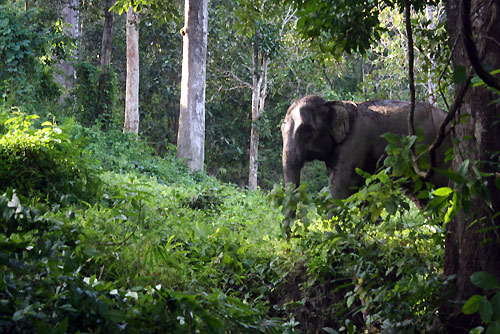
Maesa Elephant Camp
I loved our visit to Maesa Elephant Camp. We were the only overnight visitors during our stay. We were assigned a bilingual staff member, two mahouts (elephant keepers) and their elephants. Mui, our liaison, took all the photos, talked us through stuff, and was constantly cheery and friendly. Mr. May, 10 year old DuanPen’s mahout, was often stern due to his military background but his sense of humour was good and he was careful with our safety. Handsome young Mr. Don handled 39 year old Mae Noi, our balky elephant friend and primary mount.
Based on the camp’s website, I anticipated a morning of classroom lessons on elephant physiology and psychology when we arrived, but after a ten minute walk through a hall of elephant photos and anatomical drawings, we changed into our ‘mahout suits” then watched an elephant show where the elephants played harmonicas, threw darts at balloon targets and painted pictures. Highly entertaining.
And then we were riding elephants!
“Grab her ear and her skin here, and then she puts up her foot for you. Step up her foot and put your leg over her. Sit on her neck. Put your feet in behind her ears.” Mui explained. And that is how you ride an elephant. Simple.
Actually, it is is as simple as that. Riding an elephant isn’t far off riding a horse. There’s a similar motion and need to balance. It’s tiring but gets easier with practice. Mae Noi definitely knew we were new riders and ignored most of our commands in favor of stopping for a drink or a few bites of tasty grass. Mr. Don confided that she doesn’t really listen to him, either. Mr. May’s commanding voice often got her moving, but she even ignored him. Headstrong elephant!
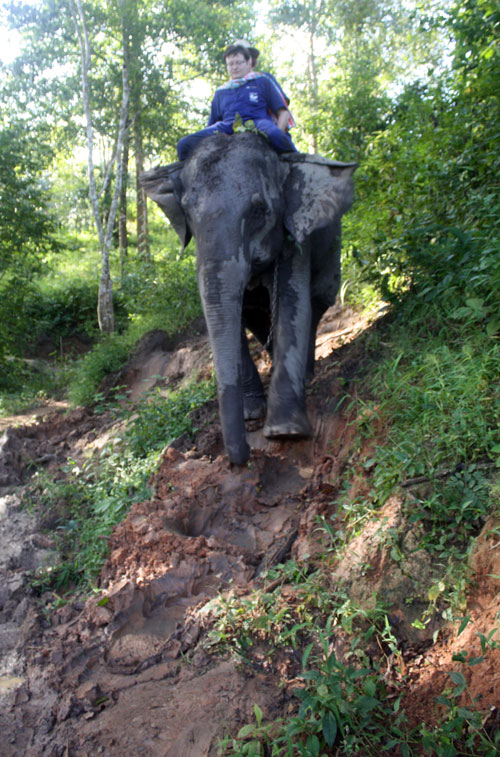
We rode her into the jungle the first afternoon and hiked back to camp in our flip flops. It was hot and exhausting and our shoes were sucked into the mud more often than not. We begged off going back for her the next dawn in favor of resting our aching thighs and backs.
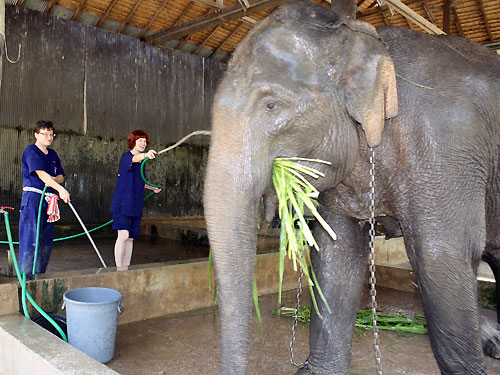
Elephants love to be wet, so we bathed our elephants in the river by splashing them with water from wicker baskets and brushing them. On the morning of our last day, after Mae Noi had spent the night getting herself covered in jungle mud, we used the elephant shower to hose her down and wash her off with soap.
We ate well, too. Breakfast was served after our morning jungle hikes/rides, then a large lunch in the afternoon, and we had cooking lessons with the camp cook at dinner time. Each meal I looked at the multitude of dishes and thought “Way too much food,” but hunger snuck up on me and I nearly always finished what had been laid on the table.
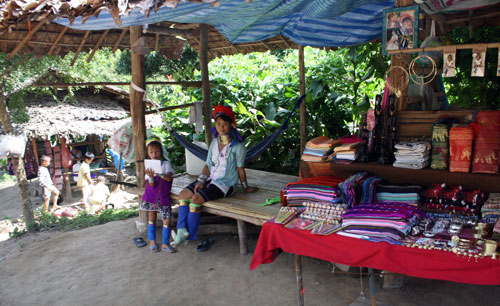
One afternoon we saddled up Mae Noi and climbed the mountain to the hilltribe village. It is a model village, government sponsored, with a central fish pond and lovely thatched houses. The villagers peddle their wares for tourists and run a good restaurant, too. There is a comfortable symbiosis between the village and the camp; commerce flows between them in the form of food, tourists, and jobs. In the evenings after the camp closes to day visitors, motorbikes speed up the hill and return with chickens and fish and other ingredients. Kids from the village come down to play soccer on the camp pitch. Dogs have friends in both places.
Some of the mahouts are villagers who go home at night. About half the mahouts live in the camp with their families. We walked through the mahout area with Mui for a look. It’s a bit squalid, I guess, but the huts are comfortably lived in and everyone seems happy. We discovered that Mr. May runs the camp cockfighting ring and had a peek at some of the contenders, who were housed in special wicker cages.
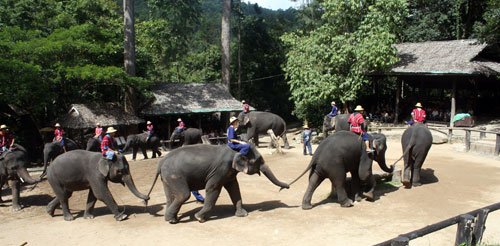
We had a chance to ride in the show parade on our last day. It was tempting to take off my hat and wave at the crowd, but DuanPen was a bit frisky so I settled for “staying on elephant” as my show trick. After the show, we played soccer with DuanPen and she painted pictures with us. We fed her and Mae Noi a pile of bananas, then it was time to leave.
When we left Maesa, I was so happy I nearly cried. We’d had a great time with the people and elephants there. I would absolutely recommend it to anyone. If you want to see more pictures, check my Flickr set all taken by Mui and presented to us on a CD to take home.
Elephant Nature Park
Elephant Nature Park is a completely different place. ENP rescue elephants from terrible conditions and give them a happy home with lots of freedom. No tricks or shows for visitors, just elephants ranging around a large field interacting with one another in a natural elephant way. They seem very happy and they are certainly well-loved by Lek, the park’s founder, and all the staff there.
Even though these elephants come from different places, they form new family groups together. For example, there are several cows with babies and each has attracted a set of “aunties” who help to care for the little ones. If a baby gets spooked and squeals, mum and the aunties rush over to form a protective shield around the baby. The disabled elephants look out for one another. The younger elephants frolic together and swim in the river. It is heartening.
Elephant interaction with the visitors is not entirely restricted. Twice a day the elephants come in near the buildings to get baskets of bananas and other produce. Visitors are encouraged to feed them from the balcony, then allowed to go down to the river to splash and scrub them. There is a “close up with babies” time when you can try to get close to them, but they are frisky and unpredictable, so up close can equal ‘trod upon’ if you aren’t alert.
In addition to the day visitors, there are overnighters and volunteers. Volunteers spend their days helping out with poop cleanup, road building, vegetable harvests, building maintenance and so on. Overnighters do the day programme twice, but get to sit in on the evening activities with the volunteers and get a special walk in the big field with the elephants in the morning.
The volunteers, while doing selfless work, are mostly oddballs. Very dedicated but vapid. Not critical at all nor interested that there is a spectrum of options. I didn’t want to see what would happen if I made one of them follow the logical conclusion of ENP’s grand missions: returning all elephants to the wild requires people to give back the land that used to be elephant jungles (which is much of inhabited Thailand).
Lek herself is celebrated as a brilliant conservationist worldwide and simultaneously despised by the local elephant tourism operators whom she condemns. She is thwarted by the tourism industry and tells stories of hearing that she is dead and her park is closed. She is passionate, well spoken and has very lofty goals that she tackles one elephant at a time. Her colleagues are equally passionate and dedicated.
As much as I truly admire the work they are doing for elephant rights at ENP and am delighted at how happy the elephants are, I wouldn’t go back.
My problems began on the van ride to the park with a documentary that explained the history and work of the park and showed some of the brutal conditions of the elephants that had been rescued. Our tour guide continued the education with stories of elephant torture, rape and other horrors. I would have preferred if he had found a more positive delivery for the ENP message, rather than constantly reminding me of how terrible humans can be to animals. It was a bit like being in a PETA workshop. I hoped this was just a bad guide. He was overzealous and bossy. Others at the park were nicer but they all had the same depressing spin on their work: elephants are victims and people are bad.
ENP does good in an imperfect world and is trying to right wrongs. That is worth supporting. But if you are thinking of going, I suggest a day visit.
I am glad we experienced both sides of elephant tourism. Maesa was delightful and made me happy, but they might torture their elephants to make them docile and trainable. ENP was dreadful from my perspective as a visitor, but it is great for the elephants. One coin, two sides.
Posted by kuri at November 02, 2009 08:39 PMI cannot believe that you seem entertained by the idea that your fabulous Mr May also engages in Cock fighting - How stupid are you exactly ?
Lek’s Nature Park tries to educate simpletons like yourself on what cruelty an elephant has to go through in order to paint , dance etc - they go through relentless torture - sorry if that ‘s a drag but it”s the truth .
Pehaps if they were not people like you in the world , then there would be a lot more happy elephants … and people no doubt - why dont you try to have a little think and face reality …
Chloe, thanks for sharing your opinion.
You may have read intention into my writing that was not there. I was not entertained by the cockfighting but interested. It does show that there is, perhaps, a layer of cruelty running through life at the camp that impacts elephants, people and cocks alike. Or maybe it points out that not all people and cultures hold the same values. But I didn’t feel the need to express that conclusion; readers can think for themselves, as you did.
Lek’s project is admirable and I support her good works with elephants. But I didn’t like the way the message was delivered and found the polarised volunteers a bit creepy. The experience there did stick with me, though. Breaking elephants for training is a terrible cruelty.
But let me write about what I see as the real crux of the difference between us. Perhaps you will agree.
There is a continuum between true evil and true good - the world is not black and white. Most of the time we each have to accept compromise somewhere in a grey area for some aspects of our lives: relationships, work, health, education, location, religion, even our just causes. I’ll wager that something in your life, as in mine, isn’t ideal and you accept that imperfection as best you can.
Lots of people insist on lily-white purity but others are more tolerant of impurity. Some people find grey areas repulsive but many will not. Everyone draws his or her own conclusion on what is an acceptable shade of grey.
Apparently, I am in a darker grey area of the scale than you are, at least on the elephant issue. It’s ok for us to be different.
That is my reality and I have thought about it for a very long time. It seems that you are not of the same opinion, but again I thank you for sharing yours here. If there were not people like you in the world, then there would be a lot less opportunity to see things from a new perspective.
Posted by: Kristen (kuri) on January 3, 2010 08:57 AM